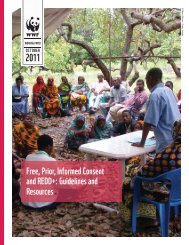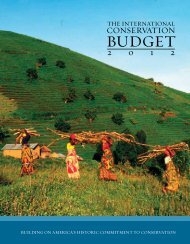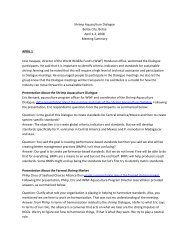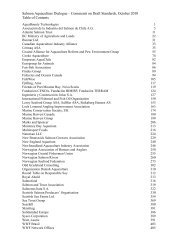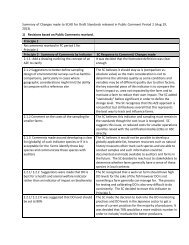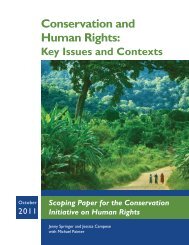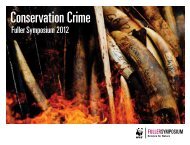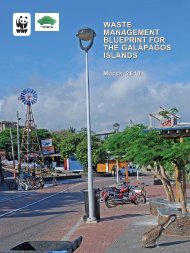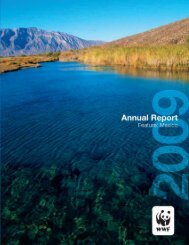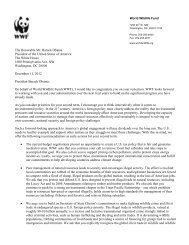Amazon - World Wildlife Fund
Amazon - World Wildlife Fund
Amazon - World Wildlife Fund
Create successful ePaper yourself
Turn your PDF publications into a flip-book with our unique Google optimized e-Paper software.
From the Field<br />
phOTO couRTEsy of GEORGE POWEll<br />
George Powell (center) with his field assistants,<br />
Jimmy Gustavo (left) and Rene Escudero (right).<br />
It took months, but eventually we<br />
learned a few things about the sakis that<br />
helped us to understand their habitat<br />
needs. We found, for example, that unlike<br />
other monkeys, this rare species does not<br />
phOTO couRTEsy of GEORGE POWEll<br />
Like the big cats, peccaries – pig-like<br />
animals that live in groups of up to<br />
1,000 and are a key source of food<br />
for the Amur Indians – also prefer to<br />
feed in the flood plains of larger rivers.<br />
There they find the palm nuts they<br />
depend on for sustenance. Because the<br />
palm trees are widely scattered except<br />
in floodplains, the peccaries must<br />
travel from river to river, often covering<br />
30 to 40 miles in search of a new<br />
feeding area.<br />
Macaws, we learned, also travel great<br />
distances − up to 100 miles − when not<br />
nesting. The team captured and tagged<br />
these amazing birds by erecting scaf-<br />
and protected areas are considerably<br />
smaller than this total. We will need<br />
to ensure that there is sufficient connectivity<br />
between parks and reserves<br />
to allow these species to maintain large<br />
enough populations.<br />
I came to recognize the importance of<br />
this kind of information decades ago,<br />
when I was doing my graduate work in<br />
Costa Rica studying the habitat of the<br />
quetzal, a strikingly colored tropical<br />
bird. Sadly, in those days national park<br />
boundaries were determined based on<br />
politics, rather than on conservation<br />
theory, and they were far less effective<br />
in protecting the native species for<br />
which they were established.<br />
Bald-faced saki<br />
Monkeys<br />
What the By Dr. George Powell<br />
Told Us<br />
The science of conservation planning<br />
requires identifying which kinds of<br />
habitat are necessary and how to integrate<br />
them into large enough areas<br />
to protect the maximum number of<br />
species. Since we clearly can’t study all<br />
of the myriad species that live in any<br />
one section of the <strong>Amazon</strong>, we selected<br />
eat ripened fruit, but prefers the seeds<br />
of immature fruit. We also learned that,<br />
unlike other monkeys, the saki does not<br />
come crashing through the trees but<br />
quietly slips from branch to branch,<br />
travelling in small families of five or<br />
six, rather than in larger groups. That<br />
means they need to live in dense, mature<br />
forested areas where the branches are<br />
close enough together for them to travel<br />
without making much noise.<br />
folding up to 100 feet high in order to<br />
reach their nests.<br />
We’ll now compile all of these data into<br />
an assessment to determine how much<br />
area we believe needs to be protected,<br />
and how much of each particular habitat.<br />
Clearly, the area will be large −<br />
likely millions of acres. An immediate<br />
concern arises from this conclusion<br />
because most individual national parks<br />
Though we had to stop our work earlier<br />
than we wanted for lack of funding,<br />
I am confident that the information<br />
we’ve gleaned from tracking these<br />
disparate species will enable decision<br />
makers to better protect the abundance<br />
of wildlife that calls the Peruvian<br />
<strong>Amazon</strong> home.<br />
Dr. George Powell is a senior<br />
conservation scientist with WWF.<br />
those suspected of being the most area-<br />
Tracking the other species, though rel-<br />
sensitive, with the assumption that pro-<br />
atively simpler, likewise taught us some<br />
tecting critical habitat for these species<br />
things that surprised us. For example,<br />
During my six years in the Madre de Dios region of the Peruvian<br />
<strong>Amazon</strong>, I learned to listen for the soft twitter that meant a family<br />
of bald-faced sakis was nearby. With my team of graduate students,<br />
local woodsmen, and former-hunters-turned-conservationists,<br />
I spent thousands of hours watching and waiting for the surprisingly<br />
hairy little monkeys to appear, only to have them vanish after<br />
a fleeting glimpse.<br />
would likewise protect areas critical to<br />
hundreds more.<br />
Unlike the other species we selected,<br />
however, the sakis, which we came<br />
to regard as the “phantoms of the<br />
jungle,” could not be captured and fitted<br />
with Gps-adapted collars to help<br />
us track their movements. To learn<br />
by capturing and collaring jaguars<br />
and pumas, we learned that these big<br />
cats behave quite differently from each<br />
other. Big cats are believed to be territorial,<br />
with individual males claiming<br />
an area exclusively. This we found to<br />
be true of the pumas we tracked, but<br />
the male jaguars overlapped territories<br />
quite comfortably.<br />
about this species, so rarely observed<br />
But watch and wait we did, because we<br />
the information we needed to determine<br />
by humans because of their talent for<br />
We were likewise surprised to see that<br />
knew that learning about the eating<br />
how much and what type of land should<br />
instantaneously disappearing into<br />
both jaguars and pumas, previously<br />
habits and distribution patterns of this<br />
be protected in this slice of the <strong>Amazon</strong>.<br />
the landscape, we had to help them<br />
assumed to live scattered throughout<br />
“umbrella species” − along with those<br />
Geneticists tell us that at least 2,000 in-<br />
habituate to us. That is, we needed to<br />
the jungle, preferred to forage along<br />
of several other far-ranging species<br />
such as jaguars, pumas, macaws and<br />
white-lipped peccaries − would give us<br />
dividuals must live in a species’ population<br />
in order for that species to be safely<br />
conserved in perpetuity.<br />
teach them not to be afraid of us, by<br />
quietly observing them for as long as<br />
they would allow it.<br />
the riverbeds. These findings indicate<br />
that protecting this species will require<br />
securing large expanses of river area.<br />
Data collected from GPS-based TrackTags worn by a male and female jaguar demonstrate the cats’<br />
affinity for riparian habitat. Human development tends to have a heavy impact on <strong>Amazon</strong>ian rivers,<br />
which are poorly represented in protected areas.<br />
10 worlDWildliFE.ORG/pulse Pulse: The hEART of consERvATion 11



